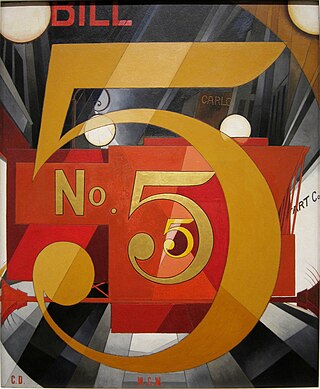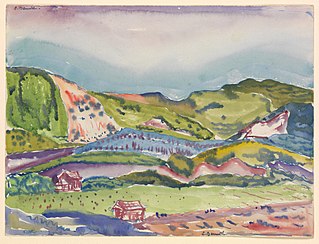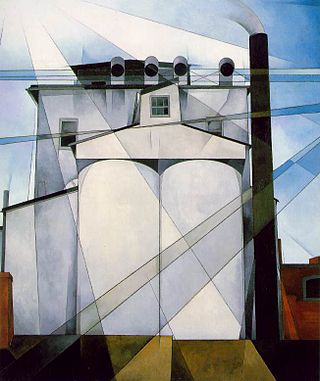
Robert Fulton was an American engineer and inventor who is widely credited with developing the world's first commercially successful steamboat, the North River Steamboat. In 1807, that steamboat traveled on the Hudson River with passengers from New York City to Albany and back again, a round trip of 300 nautical miles, in 62 hours. The success of his steamboat changed river traffic and trade on major American rivers.

William Carlos Williams was an American poet, writer, and physician closely associated with modernism and imagism.

Lancaster is a city in and the county seat of Lancaster County, Pennsylvania, and one of the oldest inland cities in the United States. With a population at the 2020 census of 58,039, it ranks 11th in population among Pennsylvania's municipalities. The Lancaster metropolitan area population is 552,984, making it the 104th-largest metropolitan area in the U.S. and second-largest in the South Central Pennsylvania area.

Charles Henry Buckius Demuth was an American painter who specialized in watercolors and turned to oils late in his career, developing a style of painting known as Precisionism.

Precisionism was a modernist art movement that emerged in the United States after World War I. Influenced by Cubism, Purism, and Futurism, Precisionist artists reduced subjects to their essential geometric shapes, eliminated detail, and often used planes of light to create a sense of crisp focus and suggest the sleekness and sheen of machine forms. At the height of its popularity during the 1920s and early 1930s, Precisionism celebrated the new American landscape of skyscrapers, bridges, and factories in a form that has also been called "Cubist-Realism." The term "Precisionism" was first coined in the mid-1920s, possibly by Museum of Modern Art director Alfred H. Barr although according to Amy Dempsey the term "Precisionism" was coined by Charles Sheeler. Painters working in this style were also known as the "Immaculates", which was the more commonly used term at the time. The stiffness of both art-historical labels suggests the difficulties contemporary critics had in attempting to characterize these artists.
American modernism, much like the modernism movement in general, is a trend of philosophical thought arising from the widespread changes in culture and society in the age of modernity. American modernism is an artistic and cultural movement in the United States beginning at the turn of the 20th century, with a core period between World War I and World War II. Like its European counterpart, American modernism stemmed from a rejection of Enlightenment thinking, seeking to better represent reality in a new, more industrialized world.

Henry McBride was an American art critic known for his support of modern artists, both European and American, in the first half of the twentieth century. As a writer during the 1920s for the newspaper The New York Sun and the avant-garde magazine The Dial, McBride became one of the most influential supporters of modern art in his time. He also wrote for Creative Art (1928-1932) and Art News (1950-1959). Living to be ninety-five, McBride was born in the era of Winslow Homer and the Hudson River School and lived to see the rise of Jackson Pollock, Mark Rothko, and the New York School.

Thomas Pollock Anshutz was an American painter and teacher. Known for his portraiture and genre scenes, Anshutz was a co-founder of The Darby School. One of Thomas Eakins's most prominent students, he succeeded Eakins as director of drawing and painting classes at the Pennsylvania Academy of Fine Arts.

Elsie Driggs was an American painter known for her contributions to Precisionism, America's one indigenous modern-art movement before Abstract Expressionism, and for her later floral and figurative watercolors, pastels, and oils. She was the only female participant in the Precisionist movement, which in the 1920s and 1930s took a Cubist-inspired approach to painting the skyscrapers and factories that had come to define the new American landscape. Her works are in the collection of the Whitney Museum of American Art, the Houston Museum of the Fine Arts, the Fine Arts Museums of San Francisco, the James A. Michener Art Museum in Pennsylvania, and the Columbus Museum of Art, among others. She was married to the American abstract artist Lee Gatch.
Gerald S. Lestz was an American newspaper columnist, author, activist, philanthropist and publisher. Lestz is credited with leading the efforts to found the Demuth Museum at the childhood home of artist Charles Demuth on East King Street in Lancaster, Pennsylvania.
Klaus Guido Grutzka was a German-American artist whose paintings and commercial art were influenced by both precisionism and abstract expressionism. Grutzka became noted for his artistic works with industrial motifs.

John Stroble Fass was an American graphic designer and a printer of fine press books. Fass designed books for the leading American publishers of limited edition books. Collectors of private press books also remember John Fass for the handcrafted books he printed on a tabletop printing press in his one-room apartment at the Bronx YMCA. Fass' books and his photography celebrate his life in New York City, where he lived most of his career. His work also documents his passion for the rural landscapes of his native Lancaster County, Pennsylvania.

William Preston Dickinson was an American modern artist, best known for his paintings of industrial subjects in the Precisionist style.

I Saw the Figure 5 in Gold, also known as The Figure 5 in Gold, is a 1928 painting by American artist Charles Demuth. It has been described as influenced by Futurism and Cubism.

The National Museum of Industrial History, abbreviated NMIH, housed in the former facility of Bethlehem Steel in Bethlehem, Pennsylvania, is a museum affiliated with the Smithsonian Institution that seeks to preserve, educate, and display the industrial history of the nation. It holds a collection of artifacts from the textile, steel and iron, and propane gas industries. The NMIH holds a significant collection of industrial machinery on loan from the institute's National Museum of American History. The museum also has a large collection of documents, machinery, photographs, and other archival material from Bethlehem Steel, one of the world's largest steel manufacturers prior to its 2001 bankruptcy and 2003 dissolution.

The Paying-out Machinery in the Stern of the Great Eastern is a watercolor by British artist Robert Charles Dudley. The work is available in the collection of the Metropolitan Museum of Art.

Mountain with Red House is a watercolor landscape painting created ca. 1913 by the American artist Charles Demuth. It is in the collection of the Metropolitan Museum of Art, in the New York.

Bermuda No. 2, The Schooner is an early 20th century drawing by American artist Charles Demuth. Done in watercolor and graphite on paper, the work depicts the ship Danish ship Elsa. The drawing is in the collection of the Metropolitan Museum of Art.

Catania and Mount Etna is a mid 19th century oil sketch by the British artist and poet Edward Lear. Done in oil on board, the work depicts Mount Etna and the surrounding Sicilian countryside near Catania. The drawing is currently in the collection of the Metropolitan Museum of Art in New York City.

My Egypt is a 1927 painting by the American artist Charles Demuth. It depicts a grain elevator from the artist's hometown of Lancaster, Pennsylvania, and is considered a "masterpiece" and "emblem" of the Precisionist art movement.

















